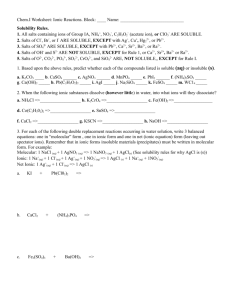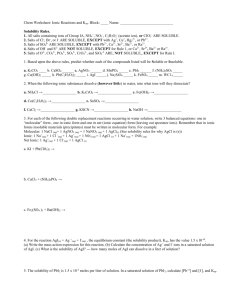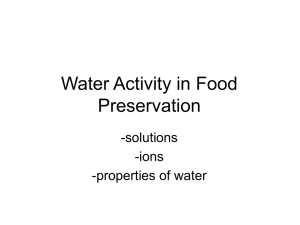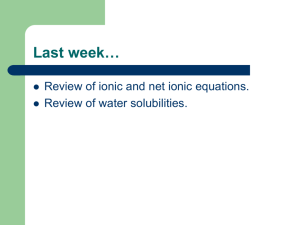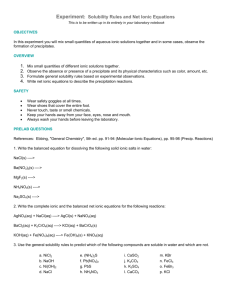lecture# 13
advertisement
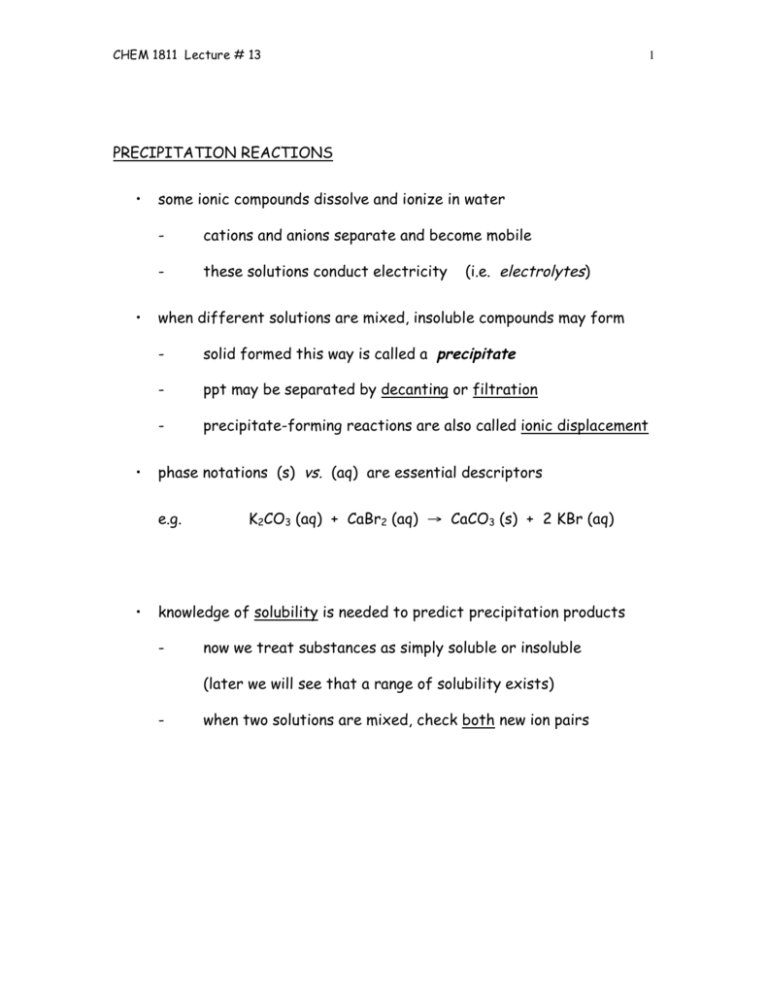
CHEM 1811 Lecture # 13 1 PRECIPITATION REACTIONS • • • some ionic compounds dissolve and ionize in water - cations and anions separate and become mobile - these solutions conduct electricity when different solutions are mixed, insoluble compounds may form - solid formed this way is called a precipitate - ppt may be separated by decanting or filtration - precipitate-forming reactions are also called ionic displacement phase notations (s) vs. (aq) are essential descriptors e.g. • (i.e. electrolytes) K2CO3 (aq) + CaBr2 (aq) → CaCO3 (s) + 2 KBr (aq) knowledge of solubility is needed to predict precipitation products - now we treat substances as simply soluble or insoluble (later we will see that a range of solubility exists) - when two solutions are mixed, check both new ion pairs CHEM 1811 Lecture # 13 2 AQUEOUS SOLUBILITY RULES (in order of precedence) 1) alkali, ammonium, nitrate, acetate, hydrogen carbonate, chlorate, and perchlorate salts ARE SOLUBLE in water 2a) most chloride, bromide, iodide and cyanide salts ARE SOLUBLE EXCEPT with Ag+ , Pb2+ , and Hg22+ 2b) most sulfate salts ARE SOLUBLE EXCEPT with Ca2+ , Sr2+ , Ba2+ , Hg22+ , Ag+ , and Pb2+ 3) most hydroxide salts are INSOLUBLE BUT Ca(OH)2 Sr(OH)2 Ba(OH)2 are slightly soluble 4) most oxide, sulfide , carbonate , chromate , phosphate , and oxalate salts are INSOLUBLE EXAMPLE Circle the soluble ionic compounds in the following list. AgNO3 SnCl2 Pb(CH3CO2)2 BaCrO4 SrSO4 Na3PO4 Fe(OH)3 CuI2 ZnS Rb2CO3 (NH4)2C2O4 TiO2 AlBr3 Hg(ClO4)2 AgCl Ca(NO2)2 WRITING IONIC EQUTIONS • ppt rxns generally have (aq) reactants and one product (s) - need to show phases - mass and charge must balance CHEM 1811 Lecture # 13 • 3 3 WAYS to write equations for reactions between ions in water 1) 2) 3) chemical (a.k.a. molecular) equation - show molecular formulas or formula units - good for overall balancing, stoichiometry total (a.k.a. complete) ionic equation - strong electrolytes are shown as separate ions - compound stoich. may become rxn stoich. net ionic equation - eliminate redundant spectator ions - best shows actual change EXAMPLE Writing ionic equations Aqueous solutions of silver nitrate and potassium chloride are mixed and a white ppt. forms; write molecular, total ionic, and net ionic equations. molecular: AgNO3 (aq) + KCl (aq) → AgCl (s) + KNO3 (aq) total: Ag+ (aq) + NO3- (aq) + K+ (aq) + Cl- (aq) → AgCl (s) + K+ (aq) + NO3- (aq) Ag+ (aq) + Cl- (aq) → AgCl (s) net: NOTES: always show charges in total and net ionic equ. all equations must balance CHEM 1811 Lecture # 13 EXAMPLE 4 Writing ionic equations Write chemical, total and net ionic equations showing the reaction between aqueous solutions of ammonium sulfate and barium bromide. Circle the spectator ions in the total ionic equation. (complete in class) chem: (NH4)2SO4 (aq) + BaBr2 (aq) → total: 2 NH4+ (aq) + SO42- (aq) + Ba2+ (aq) + 2 Br- (aq) net: Ba2+ (aq) + SO42- (aq) → BaSO4 (s) →
